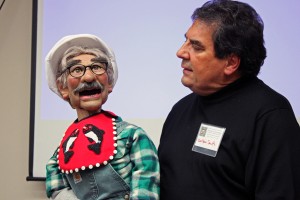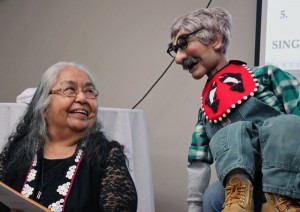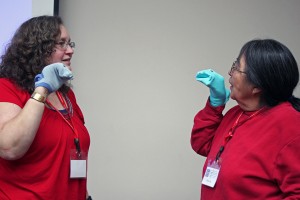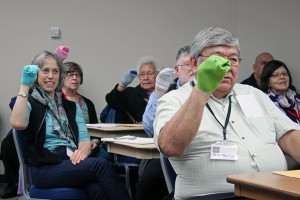Like many other indigenous languages, Tlingit is in survival mode. Revitalizing the language was the focus of this year’s Tlingit Tribes and Clans Conference held in Juneau last week.

A Juneau resident has one solution for how to keep the language alive. During a conference session, realtor and assemblyman Carlton Smith gave participants a lesson in how to teach Tlingit to children with puppets. And he does it with the help of a special guest.
Charlie introduces himself in Tlingit to the room. As is traditional, he recognizes his mother’s relatives, his fathers’ relatives, then his grandparents, and finally, he recognizes everyone else.
Charlie’s Tlingit name is Shanak’w Uwaa. He identifies his moiety (Eagle), his clan (Keet Gooshi Hit’), and where he’s from (Klukwan, or Jil’ kat kwaan).
Charlie is wearing grey Carhartt overalls, long underwear, a green and white flannel shirt, and tan work boots. He has a full head of grey hair, dark bushy eyebrows and mustache, and black-rimmed glasses.
He’s roughly three and a half feet tall and can only talk when he’s sitting on Carlton Smith’s lap.

Smith got into ventriloquism fifty years ago as a ten-year-old boy living in Haines. When Smith was bedridden with hepatitis for four months, his father bought him his first puppet from a Sears-Roebuck catalog – a red-headed figure wearing a green suit named Jerry.
“There were children walking below my bedroom window and Jerry and I were talking to them as they would walk home from school,” Smith tells the audience. “The first day or two, there were five or six children, the second day there were eight or nine. By the end of the week, there were 20 children that came to see this little green man that wanted to talk to them from a second story window.”
Like many childhood toys, Jerry was eventually forgotten, until three years ago when Smith rediscovered Jerry in a trunk.
Then, another discovery on a flight to Anchorage.
“I was looking out the window and I realized I could count to ten without moving my lips in Tlingit. And then I was going right down the list of clans and place names and I thought, ‘Oh, this is kind of cool.’”
That’s how Smith got the idea of doing Tlingit ventriloquism, but he wasn’t sure how the community would receive it. So he went to the late Tlingit elder and religious leader Dr. Walter Soboleff for advice. Soboleff liked the idea but said it couldn’t be done with Jerry. He advised Smith to create a new figure – a Native one.

“My namesake, Shanak’w Uwaa, means ‘in the image of the ancient people.’ Walter said, ‘He was one of my best friends from Kilisnoo. He said, ‘What you do is you create a brand new figure in the image of the person you’re named after.’”
As Smith looks at Charlie, he says, “That’s who this is – Shanak’w Uwaa.”
Shanak’w Uwaa is the Tlingit name of Charlie James of Klukwan, who would be 108 years old if he were alive today. Smith never met his namesake.
Using photos of Charlie James, Smith worked with a figure maker in Michigan on details like skin tone and hair color.
Charlie, says Smith, was created for one main purpose, “This is really about children.”
For a year and a half, Smith and Charlie went to Tlingit and Haida Headstart every Friday. “These little kids would just want to grab him, claw him,” Smith recalls.
Charlie would sing songs in Tlingit and count to ten.
Smith says children are captivated by the animation which makes learning Tlingit easier.
Later on in the conference session, participants are asked to pair up and make basic Tlingit dialogue with sock puppets, an activity that can be done with children. Two Tlingit teachers – Roby Littlefield and Bessie Jim – pair up.

“She asked me what my name was and I pretended not to hear her,” Littlefield says, interpreting. “So she asked me louder. One of us asked where do you live?”
Neither has spoken the language with puppets before, but both like the idea. Jim plans to bring the technique back to her students in Carcross, Yukon.
“I think they’ll get a lot more out of it and it’s more fun. And my brother used to say, ‘The language is fun.’ He said, ‘They’re always laughing,’” Jim says, laughing herself.
Littlefield says teaching with puppets can help her middle school students in Sitka with something they’re working on right now, “We’re learning the animal names and we have little stuffed animals and little hard animals. So they’re going to learn the name of the animals and then talk to each other in whatever puppet voice they choose.”
The most important thing, says Smith, is having fun. His goal at the conference was to share a different way of teaching Tlingit to children, a way that might breathe new life into a challenging task. And he hopes Charlie will help accomplish that.
Lisa Phu is a reporter at KTOO in Juneau.




